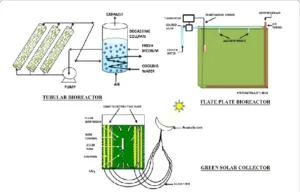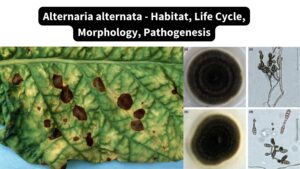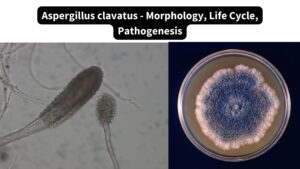Key Points on Deuteromycetes
Here are the key points summarizing the characteristics and significance of Deuteromycetes:
- Classification: Deuteromycetes, also known as ‘imperfect fungi’, belong to a group within the Kingdom Fungi.
- Reproduction: They are characterized by their asexual mode of reproduction, primarily through spores known as conidia.
- Absence of Sexual Reproduction: The lack of a known sexual reproduction cycle is a defining feature of Deuteromycetes.
- Ecological Role: They play important roles as decomposers in ecosystems, helping in the recycling of nutrients.
- Economic Importance: Some Deuteromycetes are used in industries such as fermentation and pharmaceuticals, while others can cause significant agricultural damage.
- Disease Causation: These fungi are known to cause various diseases in plants and animals, including humans.
- Mycelium Structure: The mycelium of Deuteromycetes is typically branched and septate.
- Variety of Habitats: They can be found in diverse environments, including soil, water, and as parasites on plants and animals.
- Toxin Production: Some Deuteromycetes produce toxins, which can be harmful to both humans and animals.
- Taxonomic Revisions: When sexual stages are discovered in a Deuteromycete species, it is often reclassified into other fungal groups such as Ascomycetes or Basidiomycetes.
- Diverse Group: The group encompasses a wide range of species, each with unique characteristics and ecological roles.
What are Deuteromycetes?
- Deuteromycetes, also referred to as Deuteromycota, Deuteromycotina, or fungi imperfecti, encompass a unique group within the Kingdom Fungi. Characterized by their primarily asexual mode of reproduction, these organisms are often called “imperfect fungi.” This designation arises from the historical classification system for fungi, in which organisms without a known sexual reproductive cycle were grouped separately. However, it’s important to note that if and when the sexual reproduction of these fungi is identified, they are reclassified into other fungal classes.
- One of the key features of Deuteromycetes is their method of asexual reproduction, predominantly through the formation of asexual spores known as conidia. Unlike the mycelium of Phycomycetes, which is non-septate, the mycelium in Deuteromycetes is typically branched and septate, offering a distinct structural characteristic.
- Ecologically and economically, Deuteromycetes play a significant role. They are commonly found in diverse environments, functioning either as saprophytes, which decompose organic matter, or as parasites. This dual role is crucial for nutrient cycling and mineral recycling in various ecosystems. Unfortunately, their parasitic nature also means that they are often responsible for various plant diseases and can contribute to the spoilage and degradation of food products.
- In terms of taxonomy, the classification of Deuteromycetes has been a subject of debate. Their asexual reproduction, predominantly through conidia or oidia, shares similarities with the reproductive processes in the Ascomycota phylum. However, some species also show traits akin to lower, more primitive fungi, and even the Basidiomycota phylum. This ambiguity has led to the term “Deuteromycetes” being somewhat limited in its application in modern fungal taxonomy.
- Furthermore, Deuteromycetes are sometimes colloquially known as molds. The asexual phase of their life cycle, referred to as the Anamorph stage, emphasizes their reproduction through mitosis. This classification under “artificial fungi” is a nod to their distinct reproductive process, distinguishing them from other fungi that undergo sexual reproduction. It is estimated that there are around fifteen thousand species within this group, showcasing a considerable diversity within the phylum.
- Overall, Deuteromycetes represent an intriguing and significant group within the fungal kingdom, known for their unique reproductive methods and substantial ecological and economic impacts.
Characteristic Features of Deuteromycetes
- Ecological Role:
- Deuteromycetes function as saprophytes on various substrates.
- Many are parasites on plants and animals, leading to diseases.
- Mycelium Structure:
- Mycelium is profusely branched and septate.
- Hyphae possess multinucleate cells with simple pore septa.
- Hyphae can be intercellular or intracellular.
- Cell walls primarily contain chitin-glucan.
- Mode of Reproduction:
- Reproduction is exclusively asexual.
- Methods include hyphal fragments, budding, arthrospores, chlamydospores, and predominantly conidia.
- Parasexual Cycle:
- Although sexual reproduction is absent, a parasexual cycle often occurs to meet sexual reproduction requirements.
- Environmental Impact:
- Vital in decomposing organic matter and nutrient recycling.
- Contribute to the fermentation industry by producing essential chemicals.
- Medicinal significance in synthesizing and converting steroids for pharmaceuticals.
- Toxin Production:
- Produce various toxins in stored food, feeds, and grains.
- Some toxins are carcinogenic.
- Pathogenicity:
- Cause numerous plant and animal diseases.
- Plant diseases include leaf spots, blights, wilts, rots, anthracnose, etc.
- Animal diseases encompass meningitis, candidiasis, skin and nail infections, among others.
- Mycelium Composition:
- Comprises many branched, septate hyphae.
- Cells within the hyphae are multinucleate with simple pore septa.
- Hyphae may be intracellular.
- Conidiophores and Conidia:
- Conidiophores may be free or aggregated, forming structures like Synnemata and Sporodochia.
- Conidiogenous cells produce conidia at tips or sides, singly or in chains.
- In larger formations, conidiophores form within specialized fruiting bodies known as Conidiomata.
- Sexuality and Reproduction:
- Sexual reproduction is minimal.
- A parasexual cycle typically fulfills the role of sexual reproduction.
Classification of Deuteromycetes
The Deuteromycetes, commonly known as the ‘imperfect fungi,’ are categorized into four distinct form orders based on various characteristics. Each form order represents a unique mode of reproduction and ecological niche within the group:
- Moniliales:
- Encompasses both saprophytic and parasitic fungi.
- Conidia, the asexual spores, are typically produced freely on the mycelium or on distinct conidiophores that emerge from the mycelium.
- In some species, conidiophores aggregate to form structures like sporodochia or synnemata.
- Alternative reproductive methods in this order include budding and oidia (asexual spores) formation.
- Melanconiales:
- Primarily consists of plant parasites.
- Conidia are generated either singly or in chains from conidiophores.
- These conidia are closely packed to form an asexual fruiting body known as an acervulus.
- The acervulus structure is a key characteristic of this order.
- Sphaeropsidales:
- Also includes plant parasites.
- Conidia are produced within small, globose or flask-shaped structures called pycnidia, or on modifications of such structures.
- The pycnidia are distinctive for their shape and the mode of conidia production.
- Mycelia Sterilia:
- Comprises about 20 genera and 200 form species.
- Characterized as imperfect fungi due to the absence of specialized reproductive stages including conidia.
- Reproduction occurs through vegetative means such as sclerotia (hardened masses of mycelium), rhizomorphs (root-like structures), and other vegetative forms.
Reproduction in Deuteromycetes
Reproduction in Deuteromycetes, commonly known as “imperfect fungi,” occurs solely through asexual means, with some parasexual modes also observed. Here are the key points detailing these reproductive processes:
- Asexual Reproduction:
- Deuteromycetes lack sexual reproduction.
- Asexual reproduction is the primary mode of propagation.
- Fission:
- A single cell divides into two or more daughter cells.
- Binary fission involves division into two equal parts.
- Multiple fission results in division into several parts.
- Budding:
- A form of asexual reproduction where a bud forms on a parent cell.
- The bud detaches to grow into a new, independent cell.
- Conidia Formation:
- Involves production of small, spore-like structures called conidia.
- Conidia are capable of spreading through wind or water.
- They germinate to form new fungal colonies.
- Parasexual Cycle:
- Although sexual reproduction is absent, a parasexual cycle often operates.
- This cycle fulfills some functions of sexual reproduction.
- Spore Production:
- Conidia or spores are produced either directly on the mycelium or on specialized cells called conidiophores.
- Non-Sporulating Fungi:
- Some Deuteromycetes do not produce spores.
- Propagation occurs through fragmentation of hyphae.
- Sclerotia Formation:
- A mass of hyphae called sclerotium aids in propagation.
- Sclerotia vary in size from microscopic to several millimeters in diameter.
These methods of reproduction highlight the adaptability and resilience of Deuteromycetes in various environments, contributing to their widespread presence and ecological roles.
Deuteromycetes as Pathogens
Deuteromycetes, a diverse group of fungi found in various habitats like soil, water, and plants, are significant as pathogens affecting both humans and plants. Here are key points outlining their role as pathogens:
- Human and Animal Infections:
- Commonly cause infections in humans and animals.
- Notable human infections include candidiasis (thrush), aspergillosis (lung infection), and histoplasmosis (lung infection).
- Infection Mechanism:
- Invade and colonize body tissues.
- Capable of producing toxins that damage tissues.
- Symptoms of Infection:
- Symptoms often include fever, coughing, chest pain, and shortness of breath.
- Treatment:
- Treated with antifungal medications that kill or inhibit fungal growth.
- Impact on Plants:
- A large number of Deuteromycetes species are serious plant pathogens.
- Cause various plant diseases, leading to significant economic losses.
- Toxin Production in Foods:
- Produce toxins in stored foods, feeds, and grains.
- Some toxins, like aflatoxins, are carcinogenic.
- Pathogenic to Plants:
- Thousands of species are pathogenic to plants, impacting fruits, vegetables, and other plant parts.
- Responsible for food degradation, especially in stored produce.
- Heterotrophic Nature:
- As heterotrophs, they attach to organic substrates for nutrition.
- Major food products are susceptible to fungal infestation and destruction.
- Aflatoxin Production:
- Some species, like Aspergillus flavus, produce aflatoxins.
- Aflatoxins are particularly common in products like peanuts and are harmful to consumers.
Why Deuteromycetes being called the Imperfect Fungi?
Deuteromycetes, often referred to as the “imperfect fungi,” derive their name from specific characteristics related to their reproductive methods. Below are the key reasons why they are termed as such:
- Asexual Reproduction Only:
- Deuteromycetes are recognized only for their asexual or vegetative reproductive methods.
- The absence of known sexual reproduction stages is a defining characteristic.
- Reclassification upon Discovery of Sexual Stages:
- When sexual reproduction stages are discovered in these fungi, they are reclassified.
- They typically move to different classes such as Ascomycetes or Basidiomycetes.
- Historical Classification:
- Historically, the lack of observed sexual stages led to their classification as ‘imperfect’.
- This classification was based on the then-current understanding of fungal reproduction.
- Term ‘Imperfecti’:
- The term “imperfecti” specifically refers to their lack of sexual reproduction.
- It highlights the incomplete understanding of their life cycle compared to other fungi.
- Linkage Discovery and Taxonomy:
- With advancements in mycology, linkages between asexual and sexual stages of these fungi have been discovered.
- Such discoveries have led to the reassignment of many species from Deuteromycetes to more appropriate classifications.
This term, “imperfect fungi,” is a nod to the historical context of fungal taxonomy and emphasizes the evolving nature of scientific understanding in mycology.
Examples of Deuteromycetes
Deuteromycetes, a group within the Kingdom Fungi, include various species with diverse roles in the environment. Some common examples of Deuteromycetes, along with their characteristics and impacts, are listed below:
- Cercospora:
- Known for causing plant diseases and leaf spots.
- Most species in this genus are pathogenic to plants.
- Colletotrichum:
- Functions as endophytes or phytopathogens on plants.
- Some species have mutualistic relationships with their host plants.
- Notable for causing Red Rot of Sugarcane and other plant diseases.
- Trichoderma:
- A common fungus found in various soil types.
- Generally acts as an avirulent plant symbiont.
- Tolypocladium inflatum:
- Known for producing the immunosuppressant drug ciclosporin.
- Lecanicillium species:
- Produces conidia that can control certain insect pests.
- Pochonia species:
- Currently being developed for control of nematode pests.
- Diseases caused by Deuteromycetes:
- Red Rot of Sugarcane: Caused by Colletotrichum falcatum, characterized by red stripes on leaf midribs and stems.
- Helminthosporium oryzae: Responsible for brown leaf spot in rice and linked to historical famines.
- Early Blight: Caused by Alternaria solani in potatoes and tomatoes, leading to brown spots and fruit lesions.
- Tikka Disease in Groundnut: Caused by Cercospora species (e.g., C. personata), resulting in dark brown leaf spots.
- Fusarium oxysporum:
- Causes wilts in various economically important plants like potatoes, tomatoes, cotton, and bananas.
- Characterized by sudden wilting due to xylem blockage.
- Produces chlamydospores, microconidia, and macroconidia.
- Gibberellins Production:
- First discovered in extracts of Fusarium moniliforme, causing bakanae disease in rice.
- Gibberellins are natural plant growth hormones.
- Arthrobotrys:
- A nematode-predatory fungus.
- Forms traps to capture, paralyze, and digest nematodes, thus termed nematophagous fungi.



